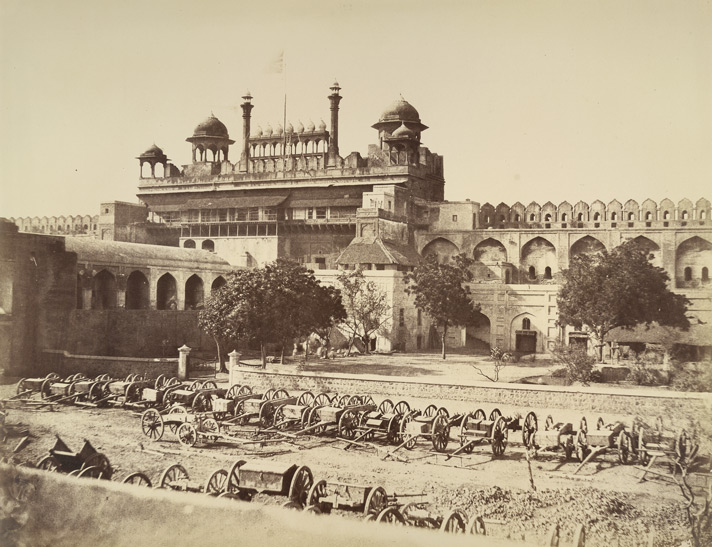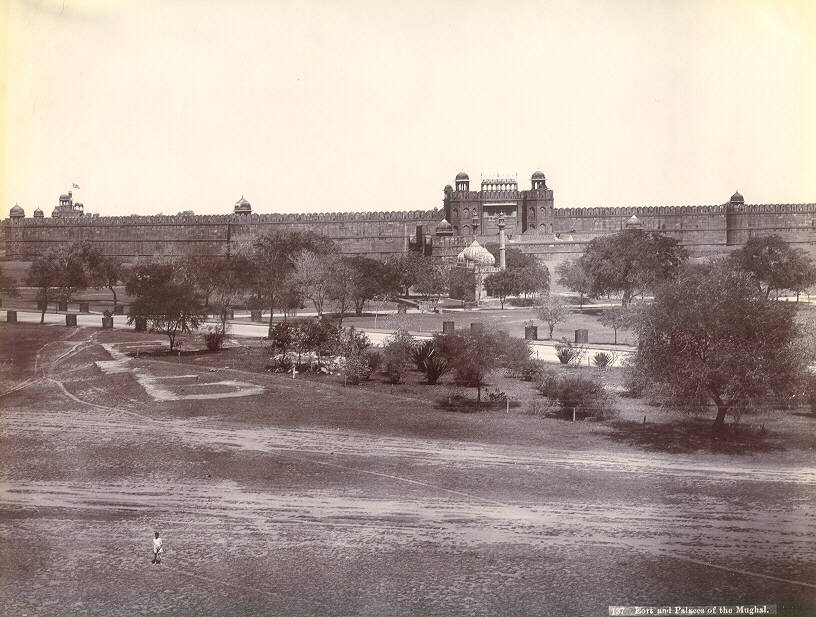
*Lahore Gate of Palace, Delhi [seen from the inside]; a photo by John Murray, 1858* (BL) [*Murray 1848*]

*Lahore Gate of the Palace, Delhi [seen from the inside]; a photo by Robert and Harriet Tytler, 1858* (BL)

A silver gelatin photo, c.1880's
Source: ebay, Nov. 2007

A view of the fort walls themselves
Source: http://www.svato.com/photos/albums/India/Red_Fort_New_Delhi.jpg
(downloaded Jan. 2006)

The ramparts around the Red Fort itself, and those around the whole walled city, were punctuated with watchtowers called "martellos"
Source: http://www.grandpoohbah.net/Grandpoohbah/images/lalqilawall.jpg
(downloaded Feb. 2006)
*A pavilion in a once-luxurious pool*
Source: http://www.twock.com/photos/india/redfort_delhi6_pool?full=1
(downloaded Feb. 2006)
The fort is an irregular octagon with its two long sides on the East (river-side), and the West (city-side), and the six smaller ones on the North and the South. The circuit of the fort is not over a mile and a half, being about 3,000 feet long and 1,800 feet broad; towards the river, the wall is about 60 feet high; it is built against the bank, and the buildings of the fort stand on a level with the top of the wall, presenting to the spectator on the opposite side a splendid panorama both of the fort and the city of Shahjahanabad. Between the river and the wall, there is a high sandy bank which is seldom under water. On the land side, the fort presents a grand view of lofty and massive red sandstone walls with a glacis and a deep ditch underneath.
The walls tower to a height of 110 feet, of which 75 feet are above the level of the ground and the ditch; the width of the walls is about 45 feet at the base, and about 30 feet where the embattled parapets stand; the ditch is 75 feet wide and 30 feet deep. Of these walls, Bernier, who visited Delhi in the reign of Aurangzeb, remarked, that they excelled those of the city in height, width, and strength. "Except on the side of the river, the citadel is defended by a deep ditch faced with hewn stone, filled with water and stocked with fish; but in my opinion," continues Bernier, "a battery of moderate force would soon level the walls with the ground. Adjoining the ditch are large gardens, full of flowers and green shrubs at all times, which, contrasted with the stupendous walls, produce a beautiful effect." These gardens have disappeared; but they might have been seen in a neglected state before the mutiny of 1857.
--Carr Stephen, Archaeology and Monumental Remains of Delhi (Author,
1876), p. 217
== Indian Routes index == Indian Routes sitemap == Glossary == FWP's main page ==